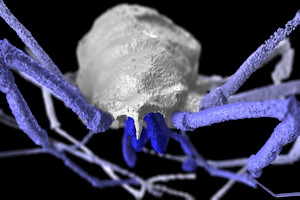Ancient “Spider” Reveals “Eye-opening” Secrets
Amazing three-dimensional images resulting from the interpretation of CT scans of a 305 million-year-old fossil have revealed that the forerunners of today’s arachnids had two sets of eyes rather than one.
Researchers from the University of Manchester, in collaboration with colleagues from the American Museum of Natural History (New York), say the highly magnified images reveal exquisite anatomical details not often found in invertebrate fossils. Writing in the journal “Current Biology”, the scientists report that this research will add a great deal to the evolutionary story of the diverse and very successful group of Arthropods, the group that includes spiders, mites, scorpions, harvestmen and ticks.
Ancient Arachnid
A False Colour Image of the Prehistoric Arachnid H. argus

Hastocularis argus – an ancient harvestmen (arachnid) that had lateral eyes unlike modern harvestmen.
Picture credit: Manchester University
Hastocularis argus
The specimen represents the primitive harvestman called Hastocularis argus. The specimen is part of a collection of Late Carboniferous (Pennsylvanian Epoch), fossils from eastern France. The CT scans and resulting computer generated images reveal that this tiny creature not only had median eyes (eyes found near the centre of the body), but eyes located on the side of the body as well (lateral eyes).
Commenting on the research, one of the co-authors of the scientific paper, Dr. Russell Garwood (University of Manchester) stated:
“Although they have eight legs, harvestmen are not spiders; they are more closely related to another arachnid, the scorpion. Arachnids can have both median and lateral eyes, but modern harvestmen only possess a single set of median eyes – and no lateral ones. These findings represent a significant leap in our understanding of the evolution of this group.”
Fossil Evidence Supported by Genetic Data
In order to confirm their analysis, the scientists examined the genes for the expression of eye stalks in extant harvestmen. They found that modern harvestmen embryos had evidence of a “switched off” part of the genetic code that hinted at lateral eye formation. Modern harvestmen have lost their lateral eyes, but the genetic evidence suggests that way back in the evolutionary history of these creepy-crawlies, lateral eyes were present.
Postdoctoral researcher, Prashant Sharma (American Museum of Natural History) commented:
“Terrestrial Arthropods like harvestmen have a sparse fossil record because their exoskeletons don’t preserve well. As a result, some fundamental questions in the evolutionary history of these organisms remain unsolved. This exceptional fossil has given us a rare and detailed look at the anatomy of harvestmen that lived hundreds of millions of years ago. What we were also able to establish is that developing modern harvestmen embryos retain vestiges of eye-growth structures seen only in the fossil.”
Dr Garwood added:
“Harvestmen fossils preserved in three dimensions are quite rare and our X-ray techniques have allowed us to reveal this exceptional fossil in more detail than we would have dreamed possible just a couple of decades ago.”
Everything Dinosaur acknowledges the help of a University of Manchester press release in the compilation of this article.
Visit Everything Dinosaur’s website: Visit Everything Dinosaur.






Leave A Comment